(May 6, 2025) In an achievement that seems like the stuff of science fiction, Singapore-based artist Lakshmi Mohanbabu has accomplished something no other artist has. Her sculptural series Interactions has not only orbited the Earth aboard the International Space Station (ISS) but has also been installed permanently seven kilometers deep in the Hadal Zone, marking a world-first on the ocean floor. The hadal zone, or hadopelagic zone, is the ocean’s deepest region that extends from roughly six to 11 kilometers below sea level, and is largely unexplored. “Yes. To the best of my knowledge, I am the only artist in the world to send art to both space and the deepest ocean,” she confirms connecting with Global Indian.
This rare feat is not a mere coincidence or luck. It has been accomplished by the artist who dared to imagine of installing her artwork at the edges of human exploration, and worked hard to make her vision turn into reality. “It’s often said that luck favours the prepared. In my case, it was never about chance, it was the result of a vision I’ve carried quietly for decades,” Lakshmi reflects.
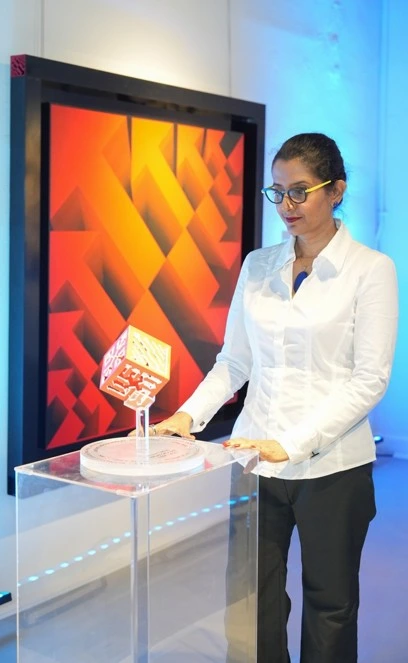
Lakshmi at Art Now Gallery, Singapore, with the red and white Hadal Descent cube that made the journey seven kms in the deep and back. In the background her Interactions primary painting – acrylic on canvas
Multiple international firsts
The artist’s series Interactions orbited the Earth from 19 February 2022 to 10 January 2023 aboard the International Space Station (ISS) and is now scheduled for permanent placement on the moon by the end of 2025. On 12 December 2024, Lakshmi witnessed one of the biggest achievement of her career with the permanent installation of her Interactions cubes on the ocean floor, seven kilometers deep, making it the world’s first-ever deep ocean floor installation of art.
This project has led to multiple international firsts. Singapore has become the first country to place art both in outer space and at the deepest point in the ocean. NTU Singapore, the institution she collaborated with, is now the first university to achieve this remarkable milestone. The Singapore Centre for 3D Printing (SC3DP), another of her key partners, also made history as the first organization to send 3D-printed art to both these extreme environments.
Beyond these institutional achievements, there are other things that matter deeply to Lakshmi. “What matters most to me is what this journey has made possible in terms of the friendships, the shared vision, and the ripple effect it has created. Many of the scientists and collaborators involved have seen their work recognised in new ways, with fresh opportunities emerging from this collective endeavour,” she remarks.
Raised by the world
Born in Trivandrum, Lakshmi never actually lived in Kerala. Her father’s postings took the family to Sikkim which was at the time still a Buddhist kingdom, and later to Afghanistan in the late 1970s. It was there, in Kabul, that the artist spent her childhood. “My time in Afghanistan was vibrant, and a culturally diverse experience which also highlighted human universality,” she recalls.
She returned to India to study architecture at Manipal University, Karnataka, where she met her future husband. Moving to Delhi, she worked with architectural firms like Rajiv Goel Architects and Benjamin and Benjamin (now Benjamin, Benjamin and Vats). But life took a surprising turn when she followed her sister into the National Institute of Fashion Technology (NIFT). After graduating in fashion design, she joined Tarun Tahiliani’s studio and was part of his very first show. She also taught at NIFT before moving to Singapore in 2001, where her creative path and artistic pursuits would expand in extraordinary directions.

Lakshmi Mohanbabu
The birth of Interactions
Her landmark project Interactions that brings together space and sea was never meant to be a typical art series. It was born from a desire to say something timeless and universal. “Interactions began as a deeply personal journey, born from a desire to create something that transcends all boundaries,” she says. Over years of refinement, this vision crystallized into nine existential elements—Creation, Lifecycles, Shape, Colour, Movement, Direction, Energy, Space, and Time. These became the building blocks of her sculptures which she looks at as a shared language to bridge continents, cultures, and disciplines.
“For me, Interactions is shaped by the unfolding of stories, woven through every connection between people, disciplines, and environments,” she says adding, “It’s a message of shared humanity, of meaning discovered in places often overlooked, and relationships formed in unexpected ways.”
How the extraordinary missions took shape
Far from accidental, these missions were the culmination of years of preparation, partnerships, and technological collaboration. It took scientists, engineers, institutions, and believers to bring it to life.
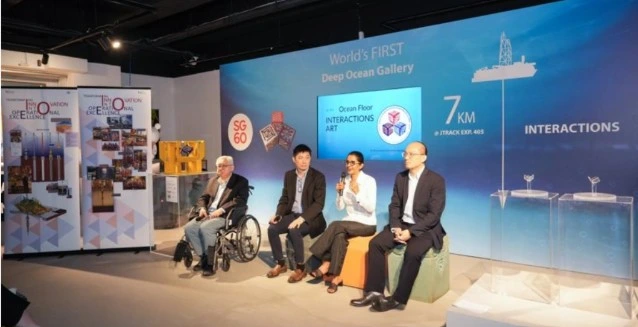
From left to right: Goi Kim Kok,Sim Guan Teo from NuStar Technologies; Lakshmi Mohanbabu; Prof Lai Chang Quan from NTU
For the space journey, two of her sculptures were launched aboard a Nanoracks mission from NASA’s Wallops Flight Facility as part of the Moon Gallery. These miniature cubes, each just 0.98 cm per side, carried her five distinct designs—Secondary, Nautilus, Primary, Windmill, and Dromenon. “One cube features Secondary alone; the other incorporates the remaining four. Developed in partnership with NTU Singapore’s School of Mechanical and Aerospace Engineering, along with the Singapore Centre for 3D Printing (SC3DP), these pieces were supported by the National Additive Manufacturing Innovation Cluster (NAMIC) and the National Research Foundation (NRF), Singapore,” Lakshmi informs.
The ocean-floor journey was equally ambitious. Lakshmi collaborated with Singapore-based NuStar Technologies, which developed custom holders to house the sculptures. These were integrated into a seismic early-warning Long-Term Borehole Monitoring System (LTBMS). The final deployment took place during the JTRACK Expedition 405 by Japan’s Agency for Marine-Earth Science and Technology (JAMSTEC), aboard the research vessel Chikyu.
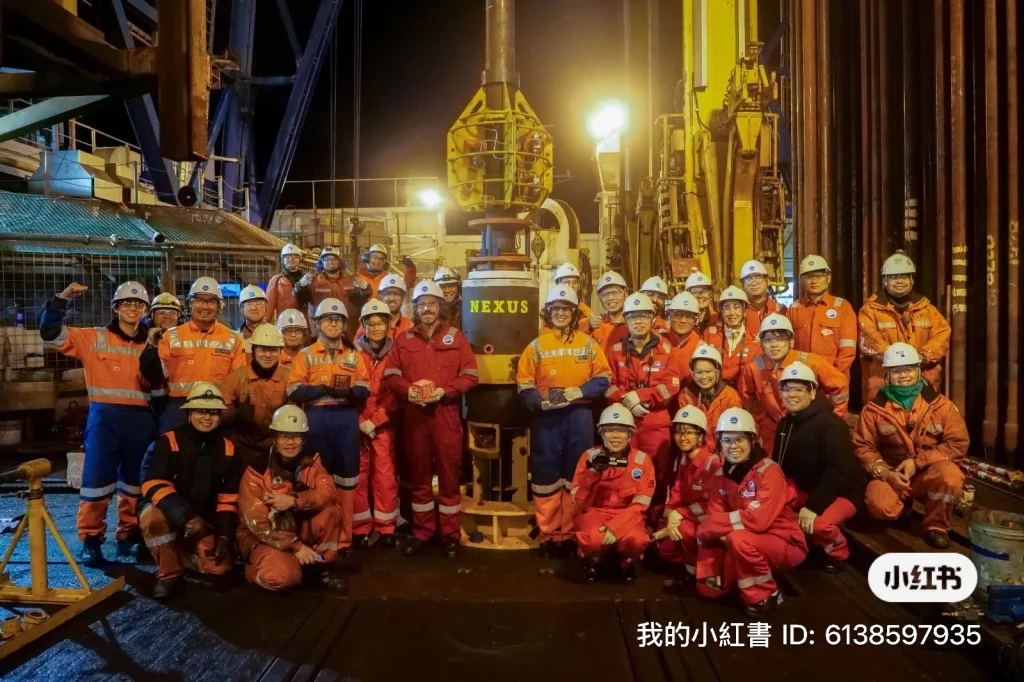
The science team that installed Lakshmi’s art work in deep sea, at the JAMSTEC scientific vessel, the Chikyu
The pathbreaking Interactions series
The Interactions series comprises five sculptural forms, each representing different forces of connection and transformation. For space, Lakshmi created two ultra-miniature cubes that orbited the Earth, flying over every city, and will eventually rest on the moon, turning the act of viewing art into a cosmic encounter.
To make this journey accessible to all, Lakshmi also created exact replicas and larger versions of the same cubes. This allows people to touch and experience the stories these pieces carry, even if the originals are millions of miles away or seven kilometers undersea.
For the deep-sea mission, she designed three 10 cm cubes, each featuring all five Interactions forms. “Each cube’s top face highlighted one design, Nautilus, Primary, and Dromenon while the rest adorned the other surfaces. A first test descent in October 2023 validated the resilience of these cubes, after which a second set was installed permanently.”
To bring this pioneering project to a wider audience, Lakshmi launched a commemorative event at Gallery Art Now in Singapore in March. Visitors experienced an immersive audio-visual journey, saw the actual trial-run Ocean Cubes, and the custom holders used in the mission.
View this post on Instagram
Engineering art for the extreme
These artworks weren’t made with ordinary materials. The first space cube was crafted from wire-cut anodized aluminum, while the second was built using a revolutionary 3D printing technique developed by NTU scientists. This method modified the metal’s crystal structure to create variable light reflections across the surface, helping the piece adapt to extreme conditions in microgravity and the harsh temperatures of space.
For the ocean-floor sculptures, Lakshmi’s team used 316 corrosion-resistant stainless steel, with all three cubes 3D printed and powder-coated for added durability. One cube, however, stood out as it was made from 304 stainless steel using a hybrid technique called Laser Patterning and Incorporation of Sheets (LAPIS). “This innovation gave it 70 percent more strength than bulk steel, crucial for withstanding pressure 700 times greater than at sea level. The designs are hollow and open to ocean water, reducing buoyancy and allowing them to stay stable at extreme depths.”
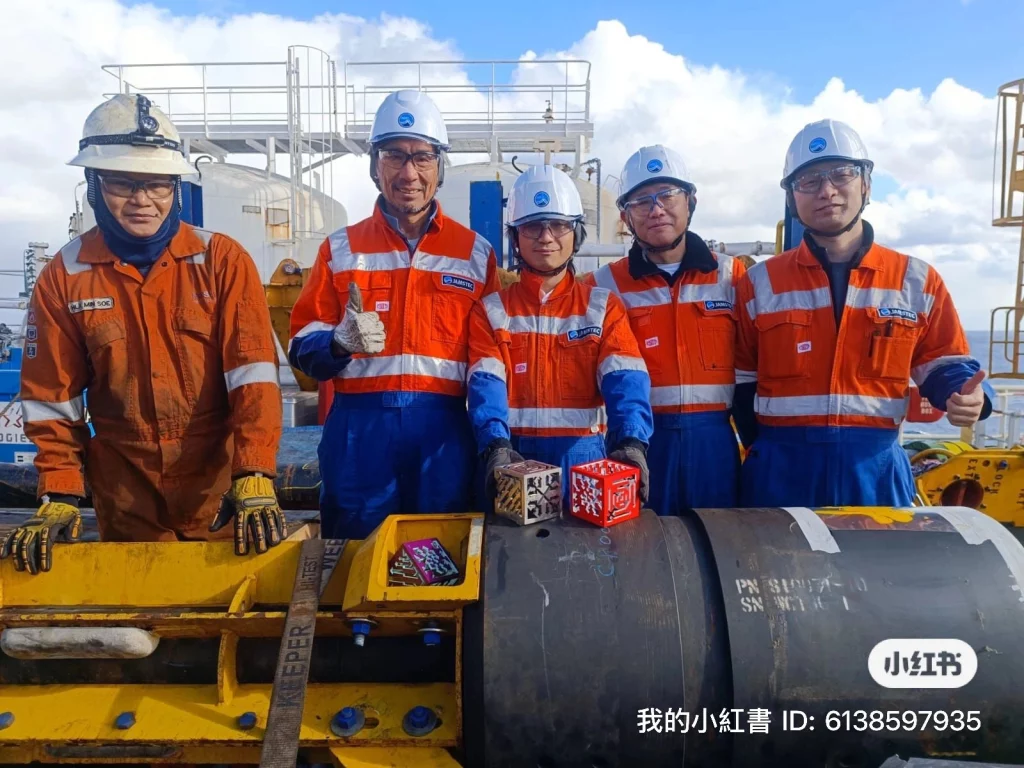
The science team just before proceeding for installation of the art work in the deep sea
Humanising science through art
The deeper meaning of Interactions lies in its ability to humanise science. “This marks the beginning of a new era, where art doesn’t merely reflect scientific progress but actively shapes its narrative. It brings emotion, context, and human connection to even the most inhospitable environments,” remarks Lakshmi.
She created the deep-sea installation in part to honour communities devastated by natural disasters and to highlight the brilliance of scientific minds working quietly behind the scenes. “It celebrates the quiet brilliance of scientific minds and engineering marvels that save lives, break barriers, and shape our world through innovation.”
Interactions also exist in the digital realm through NFTs in the Metaverse, making it the only known art series to span space, deep sea, and virtual space simultaneously. This evolution of art into multiple dimensions of existence redefines where and how art can live.
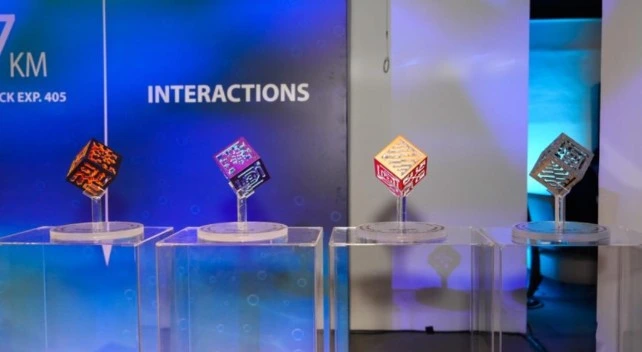
The Interactions Deep Ocean cubes. The three on the left are 3D-printed in stainless steel 316 and powder-coated. The cube on the right was created at NTU using LAPIS technology.
Recognition from the highest circles
Lakshmi’s accomplishments have been recognised by the corridors of power. “At the Deep Ocean Commemoration Event, the Guest of Honour was Ms. Goh Swee Chen, Chairman of the Board of Trustees at Nanyang Technological University (NTU Singapore) and Chairman of the National Arts Council. During the earlier 2022 ISS artwork commemoration, the Guest of Honour was Ms. Indranee Rajah, Minister in the Prime Minister’s Office,” Lakshmi informs.
Her collaborations spanned experts from NTU Singapore, JAMSTEC Japan, and NuStar Technologies Singapore, all of whom played pivotal roles in bringing her vision to life.
New visions
Lakshmi aims to launch large-scale public installations in cities around the world, each reflecting local cultures and technologies, yet echoing the heart of Interactions. The upcoming Singapore installation will pay tribute to both Singapore and Japan, incorporating the red and white colours of their flags, a symbol of the partnership that made the ocean-floor project a success.
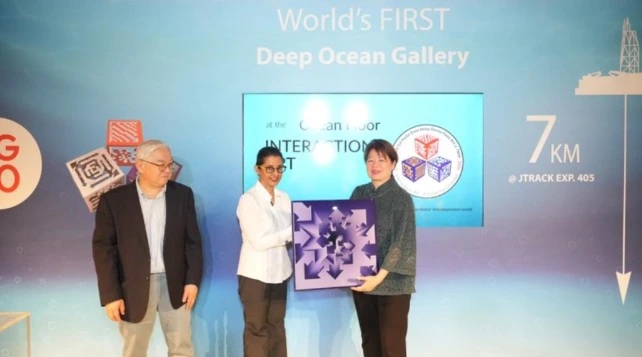
Lakshmi gifted Goh Swee Chen, Chairman of the National Arts Council of Singapore, a token of appreciation from her Interactions series during the Deep Ocean Commemoration Event
“These extraordinary missions to space and to the ocean floor were made possible because I never let go of that vision,” signs off the artist for whom every creation begins with a quietly held dream, patiently nurtured and relentlessly pursued until it takes form in the real world.
- Follow Lakshmi Mohanbabu on LinkedIn,Twitter, Instagram and Facebook
- Explore her website to know more about her artistic pursuits
ALSO READ: Jasleen Kaur wins Turner Prize for art inspired by her Scottish Sikh heritage




Hearty congratulations dear Lakshmi ( Vinu) for allowing the great artist in you which was nurtured and groomed by your dear Father and Mother to its potential scope without boundaries!!
May your creativity gets expressed and permanently established / installed in all major Art galleries and cities of the World!
May Guruvayoorappan’s Blesdings be with you , always 🙏🏻🙏🏻🤗❤️